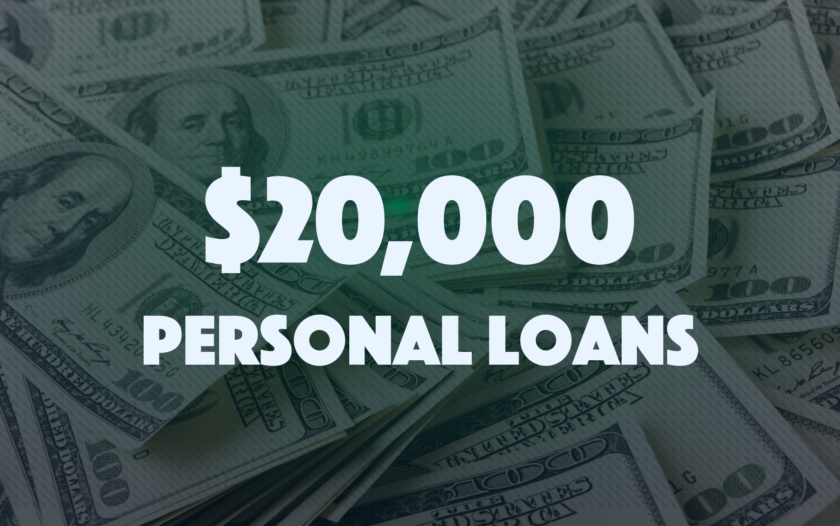How Can You Get a $20,000 Personal Loan
About Caitlyn
Caitlyn is a freelance writer from the Cincinnati area with clients ranging from digital marketing agencies, insurance/finance companies, and healthcare organizations to travel and technology blogs. She loves reading, traveling, and camping—and hanging with her dogs Coco and Hamilton.
Read full bio
At a Glance
A $20,000 personal loan can be used for just about any large expense, such as home renovations, a wedding, medical bills, or debt consolidation. However, if you need to take out a large personal loan, it’s important to remember this is a large amount of debt, so you must carefully consider your options and prepare for taking it on. Here are a few things you need to know:
How to determine if you need a $20,000 personal loan?
Because taking on a loan is such a big financial decision that should not be taken lightly, it’s important to take some steps to determine whether you need a $20,000 personal loan. For example:
1. Ask yourself why you need the loan. Are the loan funds for a ‘need’ or a ‘want’? If a ‘want,’ can it wait until you have more saved so you don’t have to borrow as much? How much do you need to borrow? Make sure you’re only borrowing what is necessary.
Some steps for taking out a $20,000 loan that could help include:
- Consolidating high-interest debt, allowing you to pay off debt faster and save money.
- Funding home improvements, which could potentially increase the value of your home.
- Paying off medical bills to avoid being sent to collections and damaging your credit.
2. Analyze your budget. Before taking out a loan, review your finances to determine whether you can afford the monthly loan payments. How much are you spending each month compared to how much income you have? Is your income able to cover your monthly expenses and the monthly loan payment? Taking on too much debt can make it difficult to repay your loan and affect long-term financial goals.
3. Check your credit score. Your credit score affects whether you’re approved for a loan, the amount you’re approved for, your interest rate, and loan terms. It’s important to have as high of a score as possible to improve your chances of approval and get the best rate and terms.
Additionally, if you end up being unable to pay off the loan, this can significantly decrease your credit score, making it more difficult to qualify for future funding.
Where can you get a $20,000 loan?
Most online lenders, banks, and credit unions offer personal loans up to $20,000 or more. However, the one that’s right for you depends on factors like whether you’re an existing customer or member, your credit score and history (as well as other qualifications), the level of customer service you want, and other factors.
1. Online lenders
Online lenders are typically able to offer the most competitive rates, and depending on the lender, they may be more likely to be able to cater to borrowers with poor credit. The application process is typically faster, and the approval and funding process usually happens more quickly (sometimes even by the next business day).
Online lenders only offer customer service support online or over the phone, but it’s typically accessible 24/7.
Find and compare the best loan options.
Use the filters below to refine your search

Sorry, we didn’t find any options that meet your requirements. Please try modifying your preferences.
Congratulations! You’re close to seeing your offers!
Please take a second to review the details you shared earlier
Sorry, we didn’t find any options that meet your requirements. Please try modifying your preferences.
2. Banks
Banks can be a good option for a personal loan, especially if you’re already an existing customer. Their interest rates tend to be higher, but they may offer discounts or other benefits to customers. However, they also usually have stricter qualifications and borrowers often need higher credit scores to be approved.
Some banks allow you to apply online for loans, while others require you to apply in-person at a local branch. The approval and funding process takes longer (usually several business days) but you have the option of in-person customer service if you need it.
3. Credit unions
Credit unions can be a great choice for personal loans because they usually offer lower rates; however, you must be a member of a credit union to apply. Credit unions also usually have less strict requirements and are able to consider factors other than your credit score such as your income, debt-to-income ratio, and membership with the credit union.
Similar to banks, approval and funding of loan funds can take a few business days.
Learn more: How credit union personal loans work?
Requirements for a $20,000 personal loan
Eligibility for a personal loan depends on the specific lender, but in general, these factors are considered when you apply:
1. Credit score: The higher your credit score, the better. In fact, it’s likely that you’ll need to have a good to excellent credit score (670 and above) to qualify for a $20,000 loan (if you want to qualify without a cosigner). A higher score will also get you better interest rates. There are lenders who work with borrowers with poor or no credit, but it’s best to take steps to improve your score as much as possible before applying.
2. Credit history: The lender will review your credit history before approving your application, which will show them your past and present accounts (like loans and credit cards). It also shows payment history, credit utilization rate, and other factors that help a lender determine the risk of accepting you as a borrower.
3. Income: It’s likely the lender will require you to provide proof of a steady income to ensure you can make your monthly loan payments.
4. Debt-to-income ratio: Your debt-to-income (DTI) ratio is all your monthly debt payments divided by your gross monthly income. This number helps show lenders if you can afford to take on a new loan, or if these monthly payments would be too much. A general rule of thumb is to keep your overall DTI ratio at or below 43%.
5. Collateral: Most personal loans are unsecured, meaning you don’t need collateral to get approved. However, if you’re applying for a secure loan, you do need proof of collateral (like a car, home, cash savings, or other asset). This lowers your risk to the lender so it may be easier to qualify for the loan and/or get a lower interest rate. However, if you default on the loan, the lender can seize your assets, so it’s important to ensure you can make the payments prior to applying.
What to consider when applying for this loan?
Before applying for a loan, there are number of factors to investigate and consider such as:
1. Repayment terms: A loan’s term is the amount of time you must repay the loan. For most personal loans, repayment terms range from two to seven years. You’ll often have a choice of repayment terms:
- A shorter repayment term means you will have a higher monthly payment, but you’ll pay less in interest over the life of the loan.
- A longer repayment term means you’ll have a lower monthly payment, but you’ll pay more in interest over time.
If you can, choosing a shorter repayment term can save you hundreds or thousands of dollars in interest over time.
2. Monthly payment: Make sure you can afford the monthly payment each month. Late or missed payments, or defaulting on the loan entirely, can significantly hurt your credit score.
3. Fees: Some lenders charge fees, which add to the overall cost of your loan. This can include origination fees, late payment fees, prepayment penalties, returned payment fees, and others. Be sure to understand what fees you may have to pay so you can be prepared.
4. Interest rates: Most personal loans have fixed interest rates, meaning the rate doesn’t change over time. However, interest adds to the overall cost of your loan. Shopping for the best interest rate can help save you money.
5. Customer service: Should you ever have a question or need assistance, it’s important to have an excellent customer service team at your disposal. Read existing and past customer reviews online and make sure you can access the service agents in your preferred way (such as online, in person, or over the phone).
6. Discounts: Some lenders offer discounts such as loyalty or existing customer discounts, autopay discounts, and others. Pay attention to any discounts you may be eligible for as this can help save you money.
Cost of obtaining a $20,000 personal loan
It’s difficult to say for sure how much a $20,000 loan will cost you because it depends on factors like:
- Your interest rate
- Lender fees
- Repayment terms
- Where you live
However, there are some ways to lower your costs:
- Choose a lender who has low or no fees.
- Choose a shorter repayment term (so you’ll pay less in interest over time).
- Make sure your credit score is as high as possible so you qualify for a lower interest rate.
- Shop around for lower interest rates.
You can use a personal loan calculator to estimate your monthly payment and the cost of borrowing.
FAQs
Personal loans can be used for just about anything, including home renovations or repairs, auto repairs, medical bills, funding a wedding, paying for a vacation, consolidating high-interest debt, moving costs, emergency or unexpected expenses, and more.
Related: Reasons to get a personal loan
Start by reviewing your credit score, income, and DTI ratio. The higher your credit score the better the interest rate and loan terms you’ll qualify for, but most lenders prefer borrowers to have a score of at least 670. Your income should be enough to cover your monthly payment, and your DTI ratio should be below 43%. You may need collateral or a cosigner if you don’t meet the lender’s requirements on your own. You’ll also need to gather information and documentation for the application such as proof of identity, proof of income/employer verification, and others.
Lenders prefer borrowers to have a credit score of at least 670 or above. Remember, the higher the credit score, the better the interest rate you’ll qualify for. Even if your score is 670 it doesn’t mean you’re guaranteed to get approved, but the higher your score is the better. However, some lenders may approve applicants with scores as low as 580.
When you apply for a loan, it triggers a hard credit inquiry on your credit report. This lowers your score by a few points for one year, though it stays on your history for two years. If you make your payments on time, you may see your score increase. However, late or missed payments, or defaulting on the loan, can significantly hurt your score.









